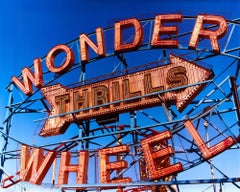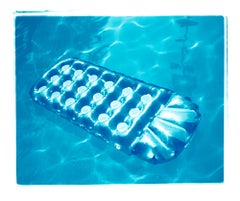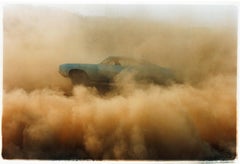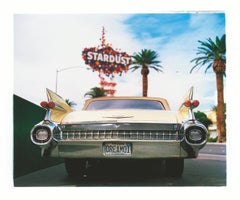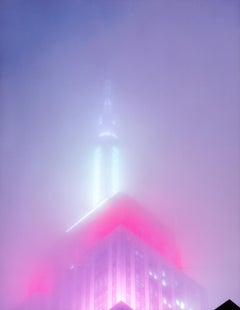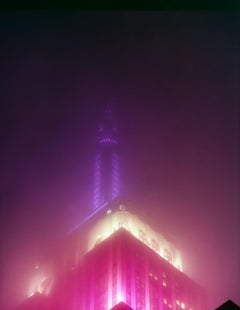More Prints
to
8
64
257
238
148
70
Overall Width
to
Overall Height
to
481
161
52
19
1
1
646
450
206
148
131
135
642
10
5
19
71
22
6
1
418
321
38
18
14
14
9
5
4
4
4
3
3
3
3
3
3
3
2
2
2
2
2
646
646
646
646
94
489
129
744
33
More Prints For Sale
Artist: Richard Heeps
Artist: Marc Chagall
Thrills, Coney Island, New York - Architectural Pop Art Color Photography
Located in Cambridge, GB
Shot in Coney Island in 2013 the iconic Wonder Wheel, a universal symbol of fun will bring a pop-of-colour to a room. This piece was selected for the 250th Royal Academy Summer Exhib...
Category
2010s Pop Art More Prints
Materials
Photographic Paper, C Print, Color, Silver Gelatin
Sun Lounger - Ballantines Movie Colony, Palm Springs, California - Color Photo
Located in Cambridge, GB
There is a cool Palm Springs California dream vibe in this summery print. There is something idyllic about the pool water and the sun lounger just waiting for you.
This artwork is a...
Category
21st Century and Contemporary Pop Art More Prints
Materials
Photographic Paper, C Print, Color, Silver Gelatin
Buick in the Dust I, Hemsby, Norfolk - Car, color photography
Located in Cambridge, GB
This photograph features an American Car on a British Beach (Hemsby, Norfolk) driven by a German. Richard spent years honing his skills as a drag racing photographer, a sport he love...
Category
2010s Contemporary More Prints
Materials
Photographic Film, Photographic Paper, C Print, Color, Silver Gelatin
Stardust Dreams, Las Vegas, Nevada - American pop art color photography
Located in Cambridge, GB
This cool picture has a classic Americana feel. Richard Heeps pictures beautiful capture parts of Las Vegas which are no longer there.
This artwork is a limited edition of 25, gloss...
Category
Early 2000s Contemporary More Prints
Materials
Photographic Paper, C Print, Color, Silver Gelatin
NOMAD IV, New York - Contemporary architectural color photography
Located in Cambridge, GB
Brand new artwork by Richard Heeps featuring the iconic Empire State building in the mist. Photographed in New York City in 2017, he just executed this in his darkroom, printing it i...
Category
21st Century and Contemporary Pop Art More Prints
Materials
Photographic Paper, C Print, Color, Silver Gelatin
NOMAD I, New York - Contemporary architectural color photography
Located in Cambridge, GB
Brand new artwork by Richard Heeps featuring the iconic Empire State building in the mist. Photographed in New York City in 2017, he just executed this in his darkroom, printing it i...
Category
21st Century and Contemporary Pop Art More Prints
Materials
Photographic Paper, C Print, Color, Silver Gelatin
'Drug Store', Ely, Nevada - After the Gold Rush Series - Pop Art Color Photo
Located in Cambridge, GB
This piece captures the iconic American Drug Store Sign, which is perfectly struck by the sunlight, against the clear blue sky creating a perfect contrast of colour and structure. Th...
Category
Early 2000s Pop Art More Prints
Materials
Photographic Paper, C Print, Color, Silver Gelatin
Marc Chagall - Hommage à Julien Cain - Original Lithograph
By Marc Chagall
Located in Collonge Bellerive, Geneve, CH
Marc Chagall - Original Lithograph
Frontispiece for André Dunoyer de Segonzac, and Julien Cain. "Humanisme Actif: Mélanges d'Art et de Littérature Offerts à Julien Cain." Paris: H...
Category
1960s Surrealist More Prints
Materials
Lithograph
Cars, Las Vegas - American Color Photography
Located in Cambridge, GB
'Cars', photograph from Richard Heeps 'Man's Ruin' Series, featuring vintage classic American cars in the Las Vegas evening sun, with delicious pastel colours.
This artwork is a lim...
Category
Early 2000s Contemporary More Prints
Materials
Photographic Paper, C Print, Color, Silver Gelatin
Hot Heads East, Finsterwalde, Germany
Located in Cambridge, GB
Taken at the traditional Drag Racing event, Hot Heads East where the spirit of motor racing is taken back to the past as Hot Rodding enthusiasts gather in Germany. Whether you're int...
Category
2010s Pop Art More Prints
Materials
Photographic Paper, C Print, Color, Silver Gelatin
Patrick's Bel Air, Las Vegas - American Car Color Photography
Located in Cambridge, GB
Capturing the cinematic Glass Pool Motel which is sadly no longer there, and an iconic Chevy Bel Air, it is a perfect example of a Lost Vegas. This is one of Richard Heeps' classic A...
Category
Early 2000s Contemporary More Prints
Materials
Photographic Paper, C Print, Color, Silver Gelatin
The Mirage, Norfolk - Vintage Car Color Photography
Located in Cambridge, GB
Part of Richard Heeps 'Man's Ruin' Series, this beautiful customised Classic American Car, against this Las Vegas themed facade is so stylish you would think it was staged, but it's ...
Category
21st Century and Contemporary Contemporary More Prints
Materials
Photographic Paper, C Print, Color, Silver Gelatin
Dice II, Hemsby, Norfolk - Pop art contemporary color photography
Located in Cambridge, GB
Part of Richard Heeps 'Man's Ruin' Series, this fun multi-colour picture has so many iconic motifs, from lucky dice, lucky number 8 and skull and cross bones.
This artwork is a lim...
Category
2010s Pop Art More Prints
Materials
Photographic Paper, C Print, Color, Silver Gelatin
Marc Chagall - Original Lithograph
By Marc Chagall
Located in Collonge Bellerive, Geneve, CH
Marc Chagall
Original Lithograph
1963
Dimensions: 32 x 24 cm
Reference: Chagall Lithographe 1957-1962. VOLUME II.
Condition : Excellent
Marc Chagall (born in 1887)
Marc Chagall was born in Belarus in 1887 and developed an early interest in art. After studying painting, in 1907 he left Russia for Paris, where he lived in an artist colony on the city’s outskirts. Fusing his own personal, dreamlike imagery with hints of the fauvism and cubism popular in France at the time, Chagall created his most lasting work—including I and the Village (1911)—some of which would be featured in the Salon des Indépendants exhibitions. After returning to Vitebsk for a visit in 1914, the outbreak of WWI trapped Chagall in Russia. He returned to France in 1923 but was forced to flee the country and Nazi persecution during WWII. Finding asylum in the U.S., Chagall became involved in set and costume design before returning to France in 1948. In his later years, he experimented with new art forms and was commissioned to produce numerous large-scale works. Chagall died in St.-Paul-de-Vence in 1985.
The Village
Marc Chagall was born in a small Hassidic community on the outskirts of Vitebsk, Belarus, on July 7, 1887. His father was a fishmonger, and his mother ran a small sundries shop in the village. As a child, Chagall attended the Jewish elementary school, where he studied Hebrew and the Bible, before later attending the Russian public school. He began to learn the fundamentals of drawing during this time, but perhaps more importantly, he absorbed the world around him, storing away the imagery and themes that would feature largely in most of his later work.
At age 19 Chagall enrolled at a private, all-Jewish art school and began his formal education in painting, studying briefly with portrait artist Yehuda Pen. However, he left the school after several months, moving to St. Petersburg in 1907 to study at the Imperial Society for the Protection of Fine Arts. The following year, he enrolled at the Svanseva School, studying with set designer Léon Bakst, whose work had been featured in Sergei Diaghilev's Ballets Russes. This early experience would prove important to Chagall’s later career as well.
Despite this formal instruction, and the widespread popularity of realism in Russia at the time, Chagall was already establishing his own personal style, which featured a more dreamlike unreality and the people, places and imagery that were close to his heart. Some examples from this period are his Window Vitebsk (1908) and My Fianceé with Black Gloves (1909), which pictured Bella Rosenfeld, to whom he had recently become engaged.
The Beehive
Despite his romance with Bella, in 1911 an allowance from Russian parliament member and art patron Maxim Binaver enabled Chagall to move to Paris, France. After settling briefly in the Montparnasse neighborhood, Chagall moved further afield to an artist colony known as La Ruche (“The Beehive”), where he began to work side by side with abstract painters such as Amedeo Modigliani and Fernand Léger as well as the avant-garde poet Guillaume Apollinaire. At their urging, and under the influence of the wildly popular fauvism and cubism, Chagall lightened his palette and pushed his style ever further from reality. I and the Village (1911) and Homage to Apollinaire (1912) are among his early Parisian works, widely considered to be his most successful and representative period.
Though his work stood stylistically apart from his cubist contemporaries, from 1912 to 1914 Chagall exhibited several paintings at the annual Salon des Indépendants exhibition, where works by the likes of Juan Gris, Marcel Duchamp and Robert Delaunay were causing a stir in the Paris art world. Chagall’s popularity began to spread beyond La Ruche, and in May 1914 he traveled to Berlin to help organize his first solo exhibition, at Der Sturm Gallery. Chagall remained in the city until the highly acclaimed show opened that June. He then returned to Vitebsk, unaware of the fateful events to come.
War, Peace and Revolution
In August 1914 the outbreak of World War I precluded Chagall’s plans to return to Paris. The conflict did little to stem the flow of his creative output, however, instead merely giving him direct access to the childhood scenes so essential to his work, as seen in paintings such as Jew in Green (1914) and Over Vitebsk (1914). His paintings from this period also occasionally featured images of the war’s impact on the region, as with Wounded Soldier (1914) and Marching (1915). But despite the hardships of life during wartime, this would also prove to be a joyful period for Chagall. In July 1915 he married Bella, and she gave birth to a daughter, Ida, the following year. Their appearance in works such as Birthday (1915), Bella and Ida by the Window (1917) and several of his “Lovers” paintings give a glimpse of the island of domestic bliss that was Chagall’s amidst the chaos.
To avoid military service and stay with his new family, Chagall took a position as a clerk in the Ministry of War Economy in St. Petersburg. While there he began work on his autobiography and also immersed himself in the local art scene, befriending novelist Boris Pasternak, among others. He also exhibited his work in the city and soon gained considerable recognition. That notoriety would prove important in the aftermath of the 1917 Russian Revolution when he was appointed as the Commissar of Fine Arts in Vitebsk. In his new post, Chagall undertook various projects in the region, including the 1919 founding of the Academy of the Arts. Despite these endeavors, differences among his colleagues eventually disillusioned Chagall. In 1920 he relinquished his position and moved his family to Moscow, the post-revolution capital of Russia.
In Moscow, Chagall was soon commissioned to create sets and costumes for various productions at the Moscow State Yiddish Theater...
Category
1960s Surrealist More Prints
Materials
Lithograph
Then the Lorde sayde unto Aaron, 'Goe meete Moses... - The Exodus
By Marc Chagall
Located in OPOLE, PL
Marc Chagall (1887-1985) - Then the Lorde sayde unto Aaron, 'Goe meete Moses in the wilderness.' And he went and met him in the mount of God and kissed him
Lithograph from 1966.
Th...
Category
1960s Symbolist More Prints
Materials
Lithograph
Adam and Eve and the Forbidden Fruit
By Marc Chagall
Located in Washington, DC
Artist: Marc Chagall
Title: Adam and Eve and the Forbidden Fruit
Portfolio: Drawings for the Bible
Medium: Lithograph
Date: 1960
Edition: Unnumbered
Sheet Size: 14 3/8" x 10 1/4"
Ima...
Category
1960s More Prints
Materials
Lithograph
Cirque
By Marc Chagall
Located in OPOLE, PL
Marc Chagall (1887-1985) - Cirque
Lithograph from 1967.
The edition of 250 on Arches paper.
Dimensions of work: 42 x 32.5 cm.
Publisher: Tériade, Paris.
Reference: Mourlot 487, ...
Category
1930s Symbolist More Prints
Materials
Lithograph
Marc Chagall - La Vache Bleue (Blue Cow) - Original Lithograph
By Marc Chagall
Located in Collonge Bellerive, Geneve, CH
Marc Chagall - Original Lithograph
La Vache Bleue (The Blue Cow)
From the unsigned, unnumbered lithograph printed in the literary review XXe Siecle
1967
See Mourlot 488
Dimensions: 32 x 24 cm
Publisher: G. di San Lazzaro.
Marc Chagall (born in 1887)
Marc Chagall was born in Belarus in 1887 and developed an early interest in art. After studying painting, in 1907 he left Russia for Paris, where he lived in an artist colony on the city’s outskirts. Fusing his own personal, dreamlike imagery with hints of the fauvism and cubism popular in France at the time, Chagall created his most lasting work—including I and the Village (1911)—some of which would be featured in the Salon des Indépendants exhibitions. After returning to Vitebsk for a visit in 1914, the outbreak of WWI trapped Chagall in Russia. He returned to France in 1923 but was forced to flee the country and Nazi persecution during WWII. Finding asylum in the U.S., Chagall became involved in set and costume design before returning to France in 1948. In his later years, he experimented with new art forms and was commissioned to produce numerous large-scale works. Chagall died in St.-Paul-de-Vence in 1985.
The Village
Marc Chagall was born in a small Hassidic community on the outskirts of Vitebsk, Belarus, on July 7, 1887. His father was a fishmonger, and his mother ran a small sundries shop in the village. As a child, Chagall attended the Jewish elementary school, where he studied Hebrew and the Bible, before later attending the Russian public school. He began to learn the fundamentals of drawing during this time, but perhaps more importantly, he absorbed the world around him, storing away the imagery and themes that would feature largely in most of his later work.
At age 19 Chagall enrolled at a private, all-Jewish art school and began his formal education in painting, studying briefly with portrait artist Yehuda Pen. However, he left the school after several months, moving to St. Petersburg in 1907 to study at the Imperial Society for the Protection of Fine Arts. The following year, he enrolled at the Svanseva School, studying with set designer Léon Bakst, whose work had been featured in Sergei Diaghilev's Ballets Russes. This early experience would prove important to Chagall’s later career as well.
Despite this formal instruction, and the widespread popularity of realism in Russia at the time, Chagall was already establishing his own personal style, which featured a more dreamlike unreality and the people, places and imagery that were close to his heart. Some examples from this period are his Window Vitebsk (1908) and My Fianceé with Black Gloves (1909), which pictured Bella Rosenfeld, to whom he had recently become engaged.
The Beehive
Despite his romance with Bella, in 1911 an allowance from Russian parliament member and art patron Maxim Binaver enabled Chagall to move to Paris, France. After settling briefly in the Montparnasse neighborhood, Chagall moved further afield to an artist colony known as La Ruche (“The Beehive”), where he began to work side by side with abstract painters such as Amedeo Modigliani and Fernand Léger as well as the avant-garde poet Guillaume Apollinaire. At their urging, and under the influence of the wildly popular fauvism and cubism, Chagall lightened his palette and pushed his style ever further from reality. I and the Village (1911) and Homage to Apollinaire (1912) are among his early Parisian works, widely considered to be his most successful and representative period.
Though his work stood stylistically apart from his cubist contemporaries, from 1912 to 1914 Chagall exhibited several paintings at the annual Salon des Indépendants exhibition, where works by the likes of Juan Gris, Marcel Duchamp and Robert Delaunay were causing a stir in the Paris art world. Chagall’s popularity began to spread beyond La Ruche, and in May 1914 he traveled to Berlin to help organize his first solo exhibition, at Der Sturm Gallery. Chagall remained in the city until the highly acclaimed show opened that June. He then returned to Vitebsk, unaware of the fateful events to come.
War, Peace and Revolution
In August 1914 the outbreak of World War I precluded Chagall’s plans to return to Paris. The conflict did little to stem the flow of his creative output, however, instead merely giving him direct access to the childhood scenes so essential to his work, as seen in paintings such as Jew in Green (1914) and Over Vitebsk (1914). His paintings from this period also occasionally featured images of the war’s impact on the region, as with Wounded Soldier (1914) and Marching (1915). But despite the hardships of life during wartime, this would also prove to be a joyful period for Chagall. In July 1915 he married Bella, and she gave birth to a daughter, Ida, the following year. Their appearance in works such as Birthday (1915), Bella and Ida by the Window (1917) and several of his “Lovers” paintings give a glimpse of the island of domestic bliss that was Chagall’s amidst the chaos.
To avoid military service and stay with his new family, Chagall took a position as a clerk in the Ministry of War Economy in St. Petersburg. While there he began work on his autobiography and also immersed himself in the local art scene, befriending novelist Boris Pasternak, among others. He also exhibited his work in the city and soon gained considerable recognition. That notoriety would prove important in the aftermath of the 1917 Russian Revolution when he was appointed as the Commissar of Fine Arts in Vitebsk. In his new post, Chagall undertook various projects in the region, including the 1919 founding of the Academy of the Arts. Despite these endeavors, differences among his colleagues eventually disillusioned Chagall. In 1920 he relinquished his position and moved his family to Moscow, the post-revolution capital of Russia.
In Moscow, Chagall was soon commissioned to create sets and costumes for various productions at the Moscow State Yiddish Theater, where he would paint a series of murals titled Introduction to the Jewish Theater as well. In 1921, Chagall also found work as a teacher at a school for war orphans. By 1922, however, Chagall found that his art had fallen out of favor, and seeking new horizons he left Russia for good.
Flight
After a brief stay in Berlin, where he unsuccessfully sought to recover the work exhibited at Der Sturm before the war, Chagall moved his family to Paris in September 1923. Shortly after their arrival, he was commissioned by art dealer and publisher Ambroise Vollard to produce a series of etchings for a new edition of Nikolai Gogol's 1842 novel Dead Souls. Two years later Chagall began work on an illustrated edition of Jean de la Fontaine’s Fables, and in 1930 he created etchings for an illustrated edition of the Old Testament, for which he traveled to Palestine to conduct research.
Chagall’s work during this period brought him new success as an artist and enabled him to travel throughout Europe in the 1930s. He also published his autobiography, My Life (1931), and in 1933 received a retrospective at the Kunsthalle in Basel, Switzerland. But at the same time that Chagall’s popularity was spreading, so, too, was the threat of Fascism and Nazism. Singled out during the cultural "cleansing" undertaken by the Nazis in Germany, Chagall’s work was ordered removed from museums throughout the country. Several pieces were subsequently burned, and others were featured in a 1937 exhibition of “degenerate art” held in Munich. Chagall’s angst regarding these troubling events and the persecution of Jews in general can be seen in his 1938 painting White Crucifixion.
With the eruption of World War II, Chagall and his family moved to the Loire region before moving farther south to Marseilles following the invasion of France. They found a more certain refuge when, in 1941, Chagall’s name was added by the director of the Museum of Modern Art (MOMA) in New York City to a list of artists and intellectuals deemed most at risk from the Nazis’ anti-Jewish campaign. Chagall and his family would be among the more than 2,000 who received visas and escaped this way.
Haunted Harbors
Arriving in New York City in June 1941, Chagall discovered that he was already a well-known artist there and, despite a language barrier, soon became a part of the exiled European artist community. The following year he was commissioned by choreographer Léonide Massine to design sets and costumes for the ballet Aleko, based on Alexander Pushkin’s “The Gypsies” and set to the music of Pyotr Ilyich Tchaikovsky.
But even as he settled into the safety of his temporary home, Chagall’s thoughts were frequently consumed by the fate befalling the Jews of Europe and the destruction of Russia, as paintings such as The Yellow Crucifixion...
Category
1960s Surrealist More Prints
Materials
Lithograph
Marc Chagall - The Bible - Naomi and her daughters-in-law - Original Lithograph
By Marc Chagall
Located in Collonge Bellerive, Geneve, CH
Marc Chagall, Original Lithograh depicting an instant of the Bible.
Technique: Original lithograph in colours (Mourlot no. 234)
On the reverse: another black and white original litho...
Category
1960s Modern More Prints
Materials
Lithograph
Cain and Abel
By Marc Chagall
Located in Washington, DC
Artist: Marc Chagall
Title: Cain and Abel
Portfolio: Drawings for the Bible
Medium: Lithograph
Year: 1960
Edition: Unnumbered
Sheet Size: 14 3/8" x 10 1/...
Category
1960s More Prints
Materials
Lithograph
Naomi and Her Daughters-in-Law, from Drawings for the Bible
By Marc Chagall
Located in Washington, DC
Artist: Marc Chagall
Title: Naomi and Her Daughters-in-Law
Portfolio: Drawings for the Bible
Medium: Lithograph
Date: 1960
Edition: Unnumbered
...
Category
1960s More Prints
Materials
Lithograph
Paris Opera Ceiling - Institute of Artistic Achievement.
By Marc Chagall
Located in Clinton Township, MI
Poster (provenance unknown). Measures 9 x 13 inches and is Unframed. Good Condition.
Category
Late 20th Century More Prints
Materials
Lithograph
La Ruche et Montparnasse
By Marc Chagall
Located in New York, NY
VIntage Chagall Poster
Category
1970s More Prints
Materials
Lithograph
